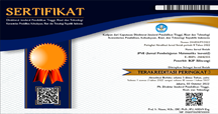ANALISIS VALIDITAS RELIABILITAS DAN INDEKS KESUKARAN PADA BUTIR SOAL MATERI BARISAN DAN DERET BERDASARKAN TAKSONOMI BLOOM REVISI
DOI:
https://doi.org/10.22460/jpmi.v4i3.p%25pKeywords:
Validity, Reliability, Tribulation Index, Sequence and Series, Revised Bloom TaxonomyAbstract
References
Andayani, M., & Amir, Z. (2019). Membangun Self-Confidence Siswa melalui Pembelajaran Matematika. Desimal: Jurnal Matematika, 2(2), 147–153.
Andriani, D., & Aripin, U. (2019). Analisis Kemampuan Koneksi Matematik dan Kepercayaan Diri Siswa SMP. Jurnal Pembelajaran Matematika Inovatif, 2(1), 25–32.
Arifin, Z. (2017). Kriteria Instrumen dalam suatu Penelitian. Jurnal THEOREMS, 2(1), 28.
Budiharto, Triyono, & Suparman. (2019). Pengaruh Teknologi Pendidikan pada Era Revolusi Industri 4.0. Jurnal Ilmu-Ilmu Sejarah, Sosial, Budaya Dan Kependidikan, 6(2), 96–114.
Diandita, E. R., Johar, R., & Abidin, T. F. (2017). Kemampuan Komunikasi Matematis dan Metakognitif Siswa SMP pada Materi Lingkaran Berdasarkan Gender. Jurnal Pendidikan Matematika, 11(2), 79–97.
Effendi, R. (2017). Konsep Revisi Taksonomi Bloom dan Implementasinya pada Pelajaran Matematika SMP. Jurnal Ilmiah Pendidikan Matematika, 2(1), 72–78.
Halik, A. S., Mania, S., & Nur, F. (2019). Analisis Butir Soal Ujian Akhir Sekolah Mata Pelajaran Matematika pada Tahun Ajaran 2015/2016 SMP Negeri 36 Makassar. Al Asma : Journal of Islamic Education, 1(1), 11.
Hasbullah, H. (2020). Analisis Butir Soal Matematika UN SMP/MTs Tahun 2018/2019 Ditinjau dari Kriteria Koneksi Matematis. Efektor, 7(1), 73–79.
Laela, U. (2019). Pengaruh Model Pembelajaran Means Ends Analysis Terhadap Peningkatan Kemampuan Pemecahan Masalah Matematis dan Self-Efficacy Siswa SMA. In Tesis pada Sekolah Pascasarjana UNPAS: tidak diterbitkan.
Maryati, I., & Priatna, N. (2017). Integrasi Nilai-Nilai Karakter Matematika Melalui Pembelajaran Kontekstual. Jurnal Mosharafa, 6(3), 333–344.
Netriwati, N. (2018). Penerapan Taksonomi Bloom Revisi untuk Meningkatkan Kemampuan Pemahaman Konsep Matematis. Desimal: Jurnal Matematika, 1(3), 347–352.
Purnawati, L., & Nusantara, T. (2020). Analisis Pertanyaan Guru dalam Pembelajaran Statistika Berdasarkan Revisi Taksonomi Bloom. AKSIOMA : Jurnal Matematika Dan Pendidikan Matematika, 11(2), 198–209.
Salmina, M., & Adyansyah, F. (2017). Analisis Kualitas Soal Ujian Matematika Semester Genap Kelas XI SMA INSHAFUDDIN Kota Banda Aceh. Jurnal Numeracy, 4(1), 37–47.
Sari, A. R., & Aripin, U. (2018). Analisis Kesalahan Siswa dalam Menyelesaikan Soal Cerita Bangun Datar Segiempat Ditinjau dari Kemampuan Pemecahan Masalah Matematik untuk Siswa Kelas VII. JPMI (Jurnal Pembelajaran Matematika Inovatif), 1(6), 1135.
Setiaji, B., Nindiasari, H., & Hendrayana, A. (2019). Pengaruh Pendekatan Metakognitif Terhadap Kemampuan Berpikir Kreatif dan Disposisi Matematis Peserta Didik Madrasah Aliyah Ditinjau dari Tahap Perkembangan Kognitif. Journal of Authentic Research on Mathematics Education, 1(2), 149–155.

















